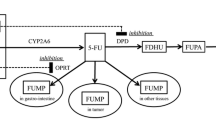Abstract
Purpose
This phase I study was designed to determine the maximum tolerated dose (MTD) and the dose to be recommended for a future phase II study of tasisulam sodium in Japanese patients with advanced, refractory solid tumors. Safety, pharmacokinetics and preliminary anti-tumor activities were assessed. Due to high-affinity albumin binding, an albumin-tailored dose to reduce the variability in tasisulam exposure was also studied.
Methods
A dose escalation scheme of tasisulam was used over 4 dose levels. Dose levels 1-3 targeted the maximum plasma concentration (C max) of 300, 340, and 360 μg/mL. Dose level 4 used an albumin-tailored range of C max-targeted doses to achieve an albumin-corrected exposure (AUCalb) of 1,200–6,400 μg h/mL, the range chosen for global tasisulam studies. Tasisulam was administered intravenously on day 1 of each 21-day (dose levels 1 and 2) or 28-day (dose levels 3 and 4) cycle.
Results
The major adverse events were related to bone marrow suppression, particularly neutropenia and thrombocytopenia. Dose-limiting toxicities (DLTs) were not observed until dose level 4, where 3 out of 6 patients experienced DLT, despite a tendency toward lower AUCalb variability (CV %) in the albumin-tailored dose group (38 %) compared with the targeted C max groups (50–236 %).
Conclusions
Tasisulam in doses up to dose level 3 (target C max 360 μg/mL) was well tolerated. Although albumin-tailored dosing provided less AUCalb variability, a MTD that aligns with other global tasisulam studies was not identified. A lower AUCalb range may be required for the Japan population.


Similar content being viewed by others
References
Corbett TH, White K, Polin L, Kushner J, Paluch J, Shih C, Grossman CS (2003) Discovery and preclinical antitumor efficacy evaluations of LY32262 and LY33169. Invest New Drugs 21:33–45
Lobb KL, Hipskind PA, Aikins JA, Alvarez E, Cheung YY, Considine EL, De Dios A, Durst GL, Ferritto R, Grossman CS, Giera DD, Hollister BA, Huang Z, Iversen PW, Law KL, Li T, Lin HS, Lopez B, Lopez JE, Cabrejas LM, McCann DJ, Molero V, Reilly JE, Richett ME, Shih C, Teicher B, Wikel JH, White WT, Mader MM (2004) Acyl sulfonamide anti-proliferatives: benzene substituent structure-activity relationships for a novel class of antitumor agents. J Med Chem 47:5367–5380
Paull KD, Shoemaker RH, Hodes L, Monks A, Scudiero DA, Rubinstein L, Plowman J, Boyd MR (1989) Display and analysis of patterns of differential activity of drugs against human tumor cell lines: development of mean graph and COMPARE algorithm. J Natl Cancer Inst 81:1088–1092
Haritunians T, Gueller S, O’Kelly J, Ilaria R Jr, Koeffler HP (2008) Novel acyl sulfonamide LY573636-sodium: effect on hematopoietic malignant cells. Oncol Rep 20:1237–1242
Meier T, Uhlik M, Chintharlapalli S, Dowless M, Van Horn R, Stewart J, Blosser W, Cook J, Young D, Ye X, Evans G, Credille K, Ballard D, Huber L, Capen A, Chedid M, Ilaria R Jr, Smith MC, Stancato L (2011) Tasisulam sodium, an antitumor agent that inhibits mitotic progression and induces vascular normalization. Mol Cancer Ther 10:2168–2178
Simon GR, Ilaria RL Jr, Sovak MA, Williams CC, Haura EB, Cleverly AL, Sykes AK, Wagner MM, de Alwis DP, Slapak CA, Miller MA, Spriggs DR (2011) A phase I study of tasisulam sodium (LY573636 sodium), a novel anticancer compound in patients with refractory solid tumors. Cancer Chemother Pharmacol 68:1233–1241
Janmahasatian S, Duffull SB, Ash S, Ward LC, Byrne NM, Green B (2005) Quantification of lean bodyweight. Clin Pharmacokinet 44:1051–1065
Kirkwood JM, Gonzalez R, Reintgen D, Clingan PR, McWilliams RR, de Alwis DP, Zimmermann A, Brown MP, Ilaria RL Jr, Millward MJ (2011) A phase 2 study of tasisulam sodium (LY573636 sodium) as second-line treatment for patients with unresectable or metastatic melanoma. Cancer 117:4732–4739
Ryan CW, Matias C, Agulnik M, Lopez-Pousa A, Williams C, de Alwis DP, Kaiser C, Miller MA, Ermisch S, Ilaria R, Jr., Keohan ML (2012) A phase II study of tasisulam sodium (LY573636 sodium) as second-line or third-line treatment for patients with unresectable or metastatic soft tissue sarcoma. Invest New Drugs [Epub ahead of print]
Scagliotti GV, Ilaria R Jr, Novello S, von Pawel J, Fischer JR, Ermisch S, de Alwis DP, Andrews J, Reck M, Crino L, Eschbach C, Manegold C (2012) Tasisulam sodium (LY573636 sodium) as third-line treatment in patients with unresectable, metastatic non-small-cell lung cancer: a phase-II study. J Thorac Oncol 7:1053–1057
de Alwis D, Cleverly A, Chow K, Troconiz I, Ilaria R (2010) Tailored dosing of tasisulam sodium (LY573636 sodium) to reduce hematological toxicity and improve therapeutic index. EJC Suppl 8:92–93
Schwartzberg LS, Soliman HH, Conlin AK, Ruud CO, Tezcan H, Bromund J, Hogeterp K, Kaiser C, Chen J, Chow K, Ilaria RL, Miller K (2012) Phase II results of tasisulam-sodium in previously treated patients with metastatic breast cancer. J Clin Oncol 30 (suppl 27; abstr 114)
Goldstein JA, Ishizaki T, Chiba K, de Morais SM, Bell D, Krahn PM, Evans DA (1997) Frequencies of the defective CYP2C19 alleles responsible for the mephenytoin poor metabolizer phenotype in various Oriental, Caucasian, Saudi Arabian and American black populations. Pharmacogenetics 7:59–64
Acknowledgments
We thank all patients who participated in this study, their families, and all the study site personnel. This study was funded by Eli Lilly Japan K.K. Gregory H. Smith, Communication Consultant to Eli Lilly Japan, assisted in writing the manuscript.
Conflict of interest
The following authors disclose relationships with Eli Lilly and Company: RI, PKT, JF, and KM are employed by Eli Lilly and HM contributed in an advisory role. The other authors declare no conflict of interests.
Author information
Authors and Affiliations
Corresponding author
Rights and permissions
About this article
Cite this article
Fujiwara, Y., Ando, Y., Mukohara, T. et al. A phase I study of tasisulam sodium using an albumin-tailored dose in Japanese patients with advanced solid tumors. Cancer Chemother Pharmacol 71, 991–998 (2013). https://doi.org/10.1007/s00280-013-2092-2
Received:
Accepted:
Published:
Issue Date:
DOI: https://doi.org/10.1007/s00280-013-2092-2




